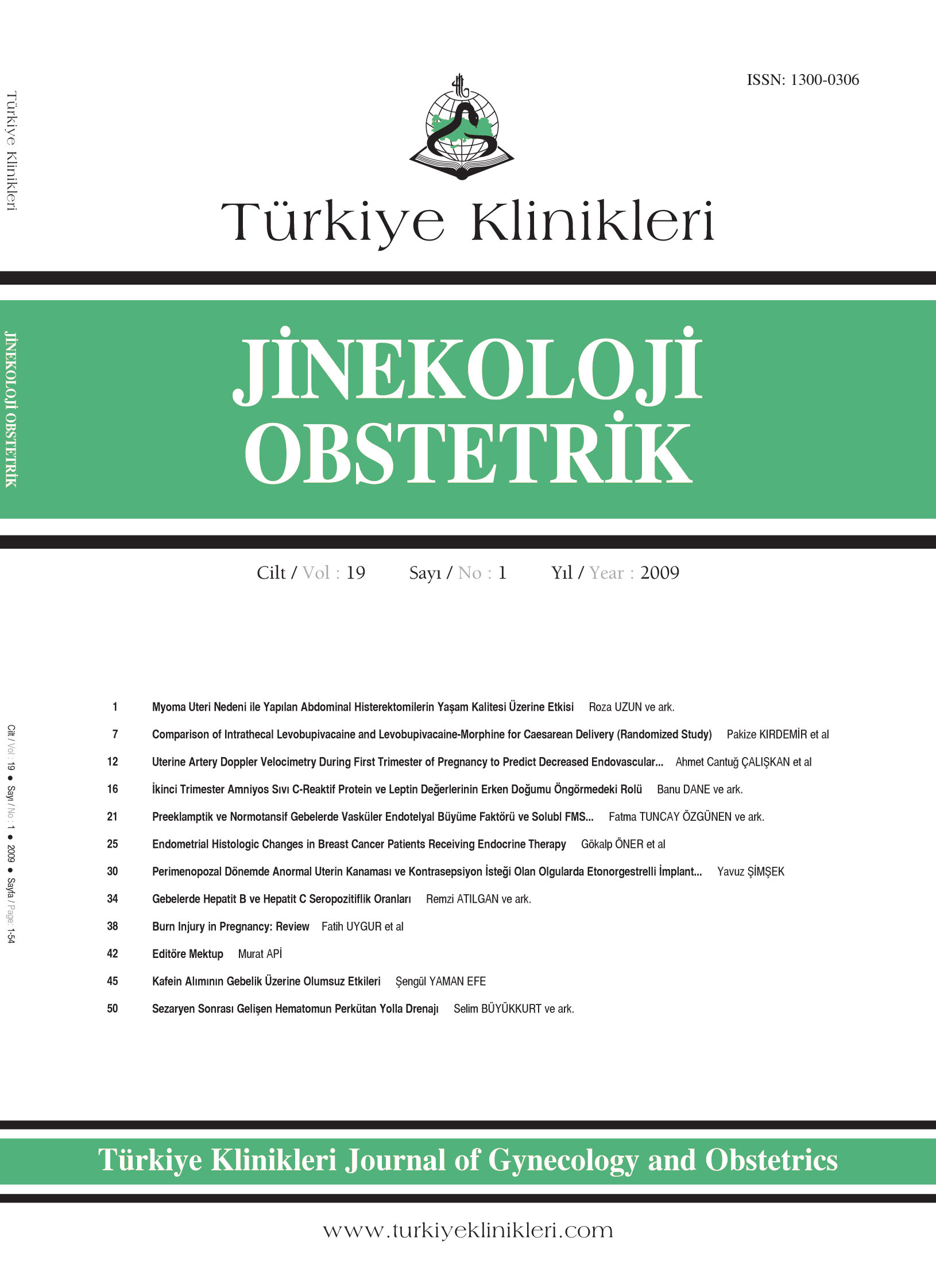Open Access
Peer Reviewed
ORIGINAL RESEARCH
3402 Viewed1211 Downloaded
The Ratio of Hepatitis B and Hepatitis C Seropositivity in Pregnants
Gebelerde Hepatit B ve Hepatit C Seropozitiflik Oranları
Turkiye Klinikleri J Gynecol Obst. 2009;19(1):34-7
Article Language: TR
Copyright Ⓒ 2025 by Türkiye Klinikleri. This is an open access article under the CC BY-NC-ND license (http://creativecommons.org/licenses/by-nc-nd/4.0/)
ÖZET
Amaç: Kesitsel tipteki bu çalışmada, hastanemize başvuran gebelerde hepatit B ve hepatit C seroprevalansı saptanarak, bu serolojik testlerin gerekliliği araştırıldı. Gereç ve Yöntemler: 1 Mart 2006-1 Eylül 2008 tarihleri arasında Rize ili İshakoğlu Çayeli Devlet Hastanesi'ne başvuran gebelere rutin obstetrik kontrolleri sırsında, hepatit B virüs yüzey antijeni HBsAg ve hepatit C virüs antikoru anti-HCV taraması yapıldı. HBsAg ve anti-HCV seropozitiflik oranları retrospektif olarak incelendi. Enzyme-Linked ImmunoSorbent Assay yöntemi ile üretici firmanın önerdiği prosedüre göre HBsAg ve anti-HCV parametreleri çalışıldı. Hastalarda bulunan pozitif değerler olgu sayısı ve % değerler olarak gösterildi. Bulgular: Rize ili İshakoğlu Çayeli Devlet Hastanesi'ne başvuran toplam 1130 gebe yaş, gebelik haftası ve sosyoekonomik durumlarına bakılmaksızın çalışmaya dahil edildi. Toplam 29 (%2.56) gebede HBsAg pozitif, 5 (%0.44) gebede anti-HCV pozitif bulundu. Araştırmada bulduğumuz HBsAg ve anti-HCV seropozitif hasta sıklıkları ülkemizdeki genel popülasyon için tespit edilen pozitiflik sınırları içerisindedir. HBsAg pozitif olan gebelerin sadece 11'i, HCV pozitif olan gebelerden ise hiçbiri taşıyıcı olduğunu tarama öncesinde bilmiyordu. Sonuç: Yenidoğanların enfeksiyondan korunmaları, bağışıklık sağlanması ve gerekli tedavi protokollerinin başlatılması ve düzenlenmesi açısından, kadınlara mutlaka gebelik öncesi ve gebelikleri sırasında özellikle HBsAg ve anti-HCV için serolojik tarama yapılmalıdır. Seropozitif anne adayları bu konuda bilgilendirilmelidir. Aşılamanın mümkün olabildiği hepatit B için, gerekli taramalar yapıldıktan sonra prekonsepsiyonel dönemde aşılama programları uygulanmalıdır. HBsAg seroprevalansının epidemiyolojik çalışmalarla tekrar gözden geçirilmesi gerektiğini düşünmekteyiz.
Amaç: Kesitsel tipteki bu çalışmada, hastanemize başvuran gebelerde hepatit B ve hepatit C seroprevalansı saptanarak, bu serolojik testlerin gerekliliği araştırıldı. Gereç ve Yöntemler: 1 Mart 2006-1 Eylül 2008 tarihleri arasında Rize ili İshakoğlu Çayeli Devlet Hastanesi'ne başvuran gebelere rutin obstetrik kontrolleri sırsında, hepatit B virüs yüzey antijeni HBsAg ve hepatit C virüs antikoru anti-HCV taraması yapıldı. HBsAg ve anti-HCV seropozitiflik oranları retrospektif olarak incelendi. Enzyme-Linked ImmunoSorbent Assay yöntemi ile üretici firmanın önerdiği prosedüre göre HBsAg ve anti-HCV parametreleri çalışıldı. Hastalarda bulunan pozitif değerler olgu sayısı ve % değerler olarak gösterildi. Bulgular: Rize ili İshakoğlu Çayeli Devlet Hastanesi'ne başvuran toplam 1130 gebe yaş, gebelik haftası ve sosyoekonomik durumlarına bakılmaksızın çalışmaya dahil edildi. Toplam 29 (%2.56) gebede HBsAg pozitif, 5 (%0.44) gebede anti-HCV pozitif bulundu. Araştırmada bulduğumuz HBsAg ve anti-HCV seropozitif hasta sıklıkları ülkemizdeki genel popülasyon için tespit edilen pozitiflik sınırları içerisindedir. HBsAg pozitif olan gebelerin sadece 11'i, HCV pozitif olan gebelerden ise hiçbiri taşıyıcı olduğunu tarama öncesinde bilmiyordu. Sonuç: Yenidoğanların enfeksiyondan korunmaları, bağışıklık sağlanması ve gerekli tedavi protokollerinin başlatılması ve düzenlenmesi açısından, kadınlara mutlaka gebelik öncesi ve gebelikleri sırasında özellikle HBsAg ve anti-HCV için serolojik tarama yapılmalıdır. Seropozitif anne adayları bu konuda bilgilendirilmelidir. Aşılamanın mümkün olabildiği hepatit B için, gerekli taramalar yapıldıktan sonra prekonsepsiyonel dönemde aşılama programları uygulanmalıdır. HBsAg seroprevalansının epidemiyolojik çalışmalarla tekrar gözden geçirilmesi gerektiğini düşünmekteyiz.
ABSTRACT
Objective: This cross sectional study is designed to examine the hepatitis B and hepatitis C seroprevalence among pregnants admitted to sur hospital and to determine the useful of these tests. Material and Methods: Pregnant women admitted to Rize Ishakoglu Cayeli Devlet Hastanesi between March 2006-September 2008 for routine obstetric controls underwent HBsAg and anti-HCV tests. HBsAg and anti-HCV seropositivity is examined retrospectively. ELISA procedure is used to examine HBsAg and anti-HCV parameters. Positive parameters are reported as case numbers and percentages. Results: 1130 pregnant women admitted to Rize Ishakoglu Cayeli Devlet Hastanesi participated in the study. These pregnant women were not grouped according to age, week of pregnancy and socieconomic status. It is found that 29 (2.56%) pregnant women were HBsAg positive and 5 (0.44%) pregnant were anti-HCV positive. These seropositivity rates are similar to general population in our country. Only 11 pregnants were aware of their HBsAg positivity before tests. None of the HCV positive pregnants were aware of their seropositivity. Conclusion: To protect neonates from infection, immunize them, to start and organize treatment protocols, women must be searched for HBsAg and anti-HCV positivity before pregnancy and during pregnancy. Seropositive women must be informed. Since immunisation is possible for hepatitis B, women must be immunised in preconceptional period. As a result, we think that HBsAg seropositivity must be searched again by epidemiologic studies
Objective: This cross sectional study is designed to examine the hepatitis B and hepatitis C seroprevalence among pregnants admitted to sur hospital and to determine the useful of these tests. Material and Methods: Pregnant women admitted to Rize Ishakoglu Cayeli Devlet Hastanesi between March 2006-September 2008 for routine obstetric controls underwent HBsAg and anti-HCV tests. HBsAg and anti-HCV seropositivity is examined retrospectively. ELISA procedure is used to examine HBsAg and anti-HCV parameters. Positive parameters are reported as case numbers and percentages. Results: 1130 pregnant women admitted to Rize Ishakoglu Cayeli Devlet Hastanesi participated in the study. These pregnant women were not grouped according to age, week of pregnancy and socieconomic status. It is found that 29 (2.56%) pregnant women were HBsAg positive and 5 (0.44%) pregnant were anti-HCV positive. These seropositivity rates are similar to general population in our country. Only 11 pregnants were aware of their HBsAg positivity before tests. None of the HCV positive pregnants were aware of their seropositivity. Conclusion: To protect neonates from infection, immunize them, to start and organize treatment protocols, women must be searched for HBsAg and anti-HCV positivity before pregnancy and during pregnancy. Seropositive women must be informed. Since immunisation is possible for hepatitis B, women must be immunised in preconceptional period. As a result, we think that HBsAg seropositivity must be searched again by epidemiologic studies
MENU
POPULAR ARTICLES
MOST DOWNLOADED ARTICLES





This journal is licensed under a Creative Commons Attribution-NonCommercial-NoDerivatives 4.0 International License.










